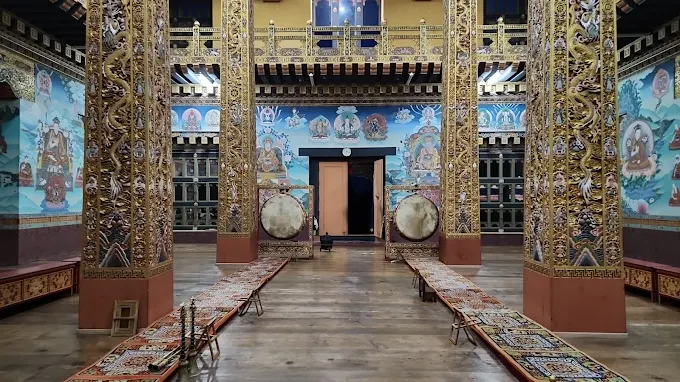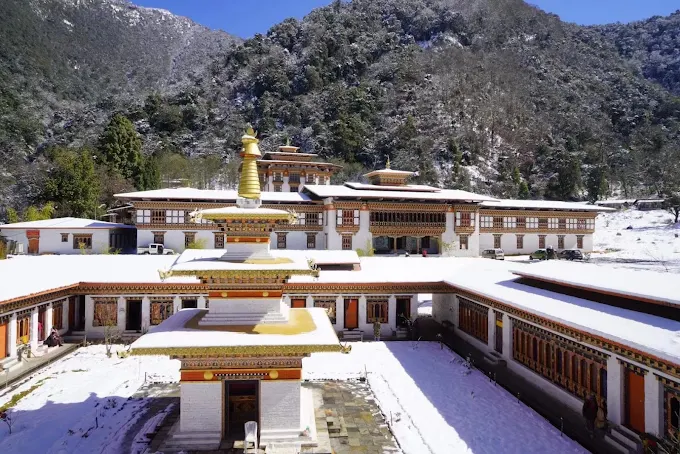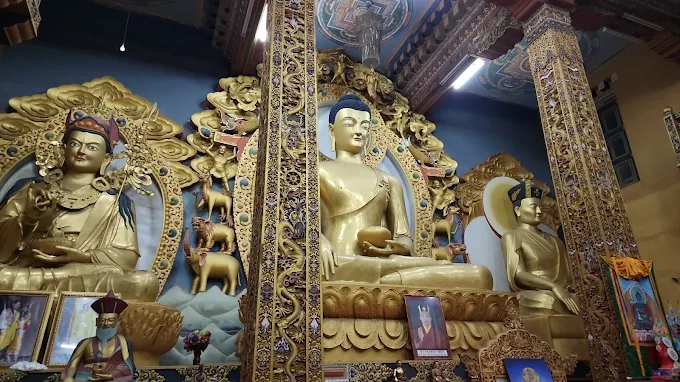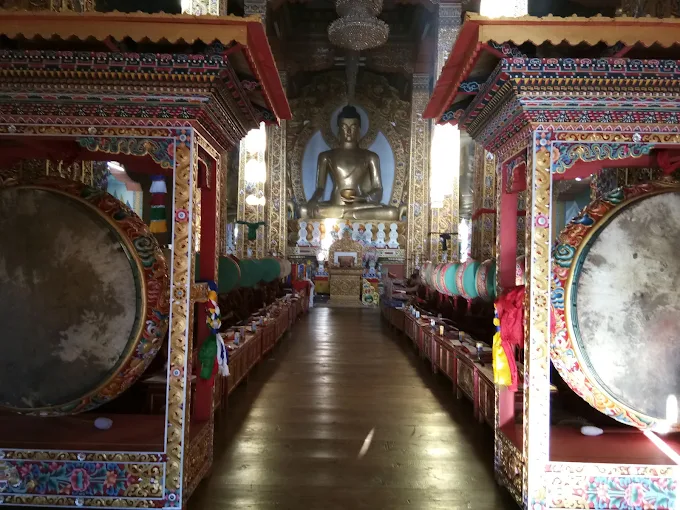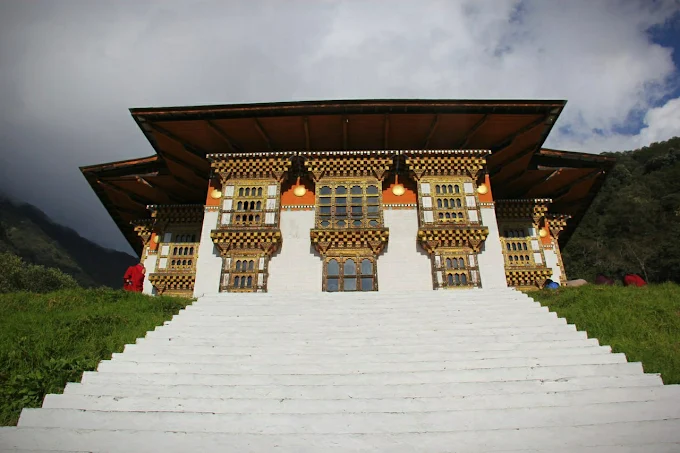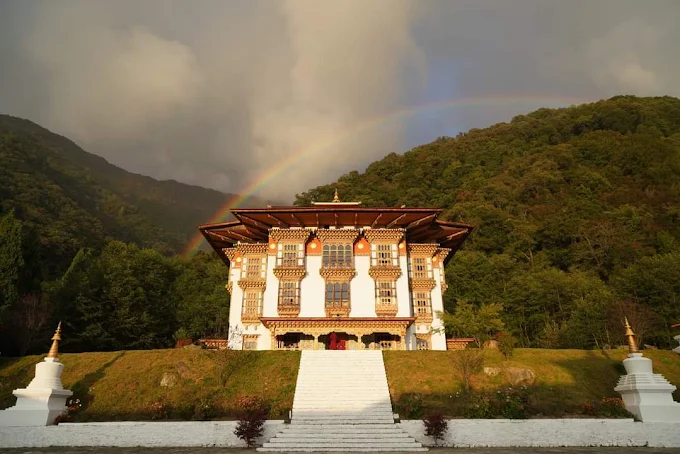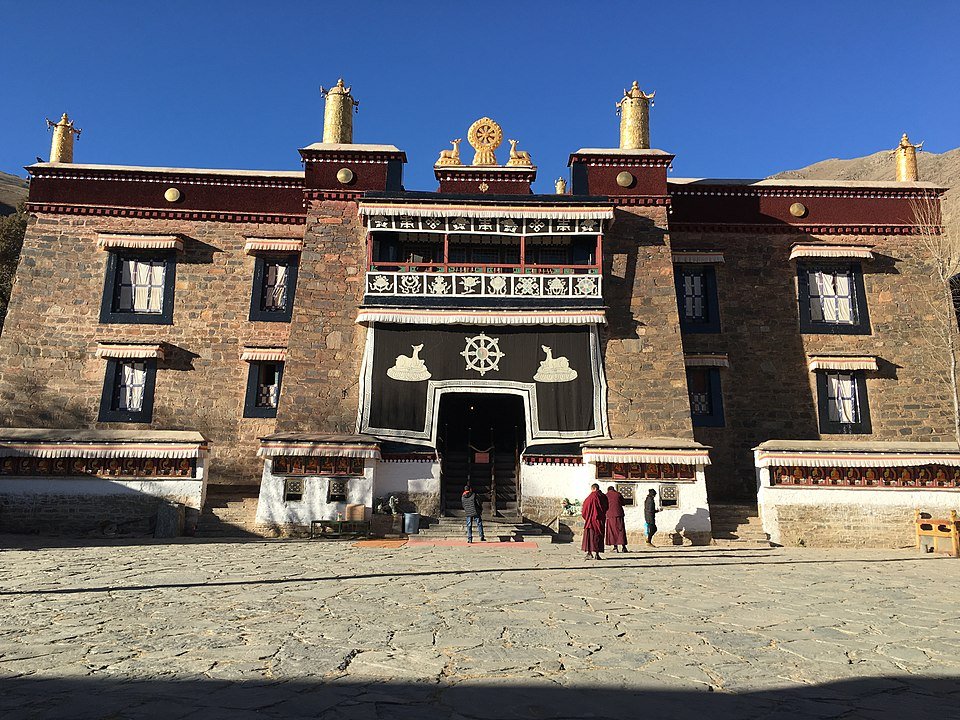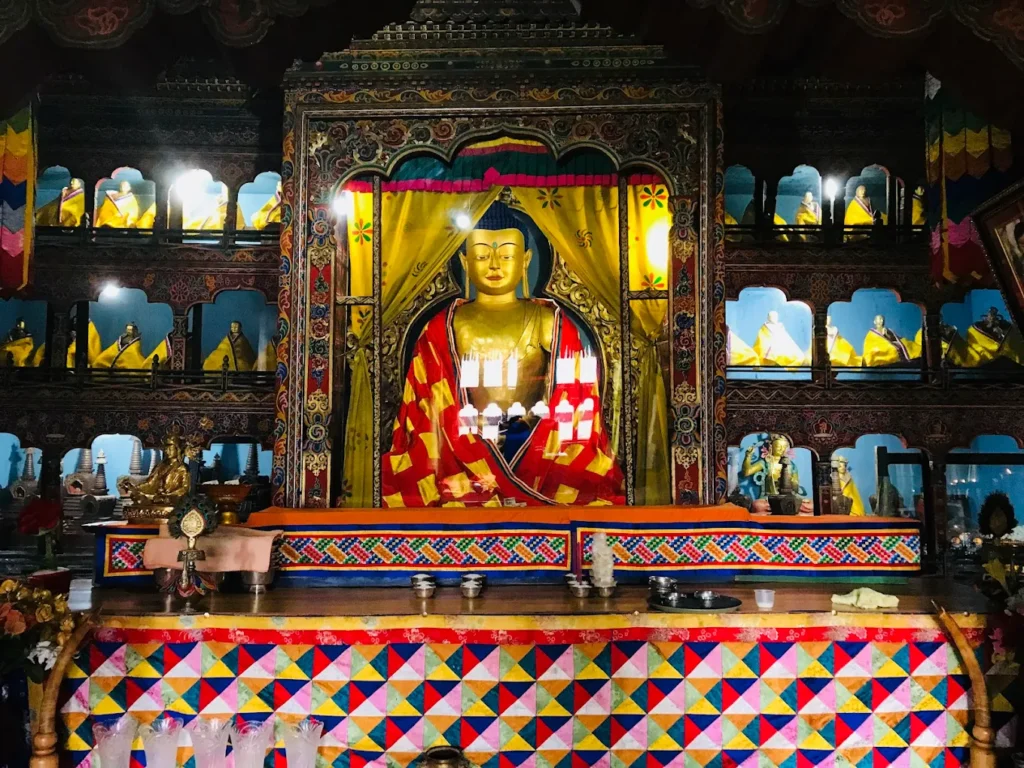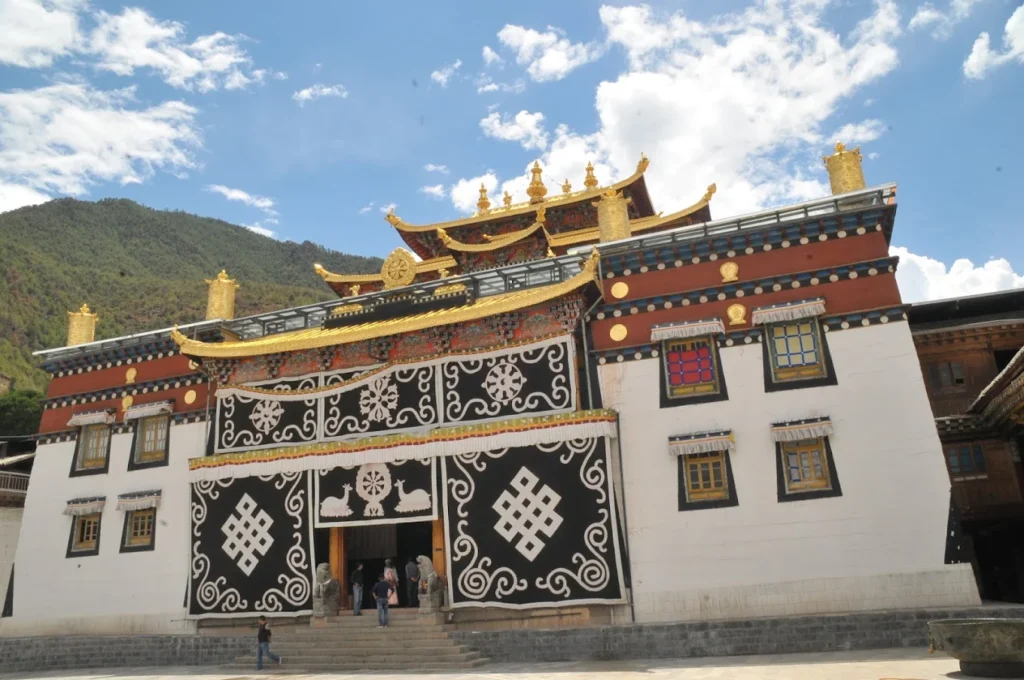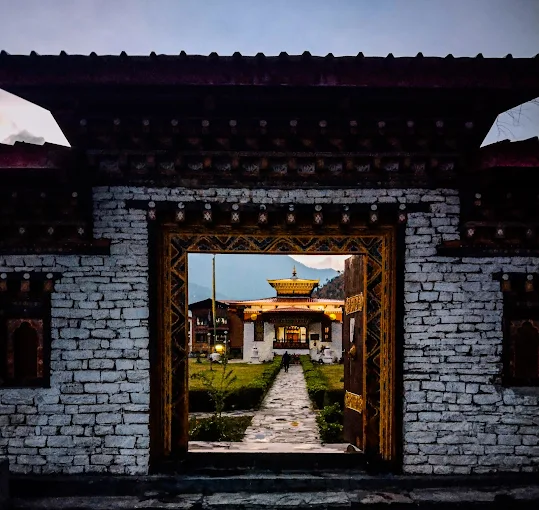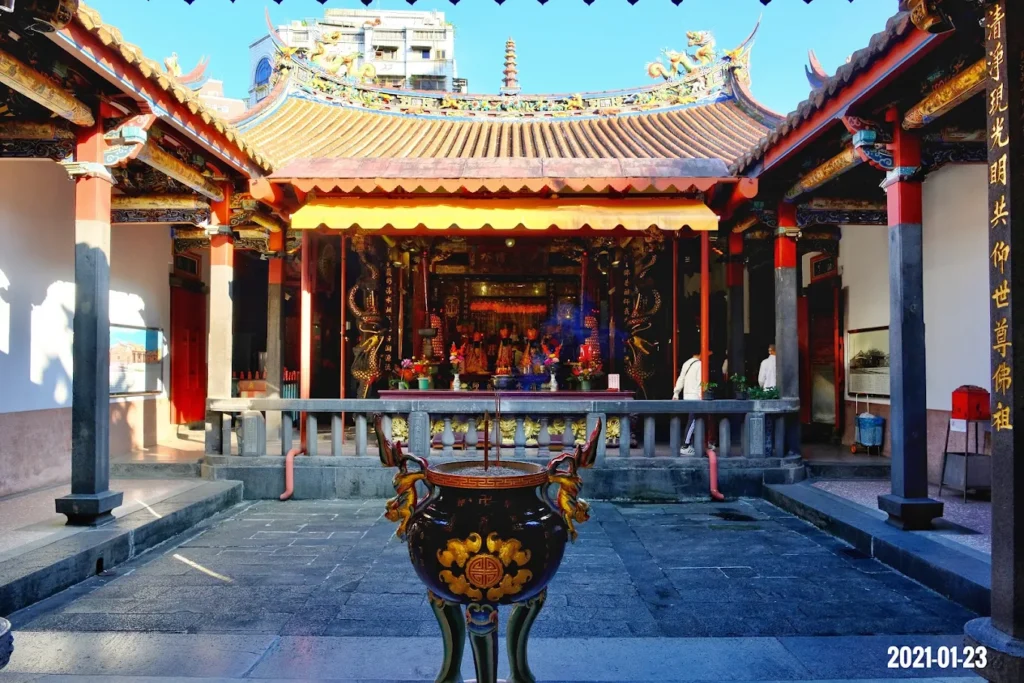Karma Thegsum Dechenling Monastery: Carved Sanctuary of Tsirang’s Kagyu Legacy
As dawn weaves through Tsirang’s forested hills, Karma Thegsum Dechenling Monastery stirs in Barshong village, its carved wooden beams catching the first light. In the main shrine, a three-story bronze Shakyamuni Buddha, modeled after Bodh Gaya’s icon, looms beside a two-story Guru Rinpoche (Padmasambhava) with Bhutanese features and the 8th Karmapa, Mikyö Dorje, their gold-inlaid forms aglow with butter lamps. During Tshechu, masked dancers swirl in the courtyard, their steps echoing the Karma Kagyu lineage’s rhythms. Founded by Zuri Rinpoche in 2004 and completed in 2016, this monastery, blessed by His Holiness the 17th Karmapa, rises as a beacon of meditation and artistry. Its 32 stupas encircle the grounds, inscribed with mantras, guarding Barshong’s Lhotshamkha community. Amid cardamom groves and mist, it offers a haven where Bhutan’s Kagyu heritage meets the pulse of village life.
Overview and Significance
Karma Thegsum Dechenling Monastery, perched in Tsirang’s Barshong village, stands as a Karma Kagyu stronghold, its gold-inlaid statues and carved wood embodying a decade-long vision of devotion. This sanctuary weaves scholarship, ritual, and community, anchoring Bhutan’s spiritual landscape.
Introduction to Karma Thegsum Dechenling Monastery
Karma Thegsum Dechenling Monastery rises in Tsirang’s lush hills, its whitewashed walls and sloped roof a testament to Karma Kagyu Buddhism, a lineage tracing from Marpa to Milarepa, emphasizing meditation and oral transmission. Initiated in 2004 by Zuri Rinpoche, with the blessing of His Holiness the 17th Karmapa, the monastery was completed in 2016, its traditional Bhutanese design blending carved wood and Karma Ghadri paintings. Serving Barshong’s Lhotshamkha-speaking villagers, it fosters enlightenment through study and ritual, its towering statues a focal point of reverence. Set against Tsirang’s forests, it offers a window into Bhutan’s Kagyu soul.
Historical Journey
The monastery’s story unfolds in Tsirang’s modern era:
- Vision (2004): Zuri Rinpoche, inspired by villagers’ pleas, proposed a monastery to the 17th Karmapa, who named it Karma Thegsum Dechenling.
- Construction: Begun on April 29, 2004, with 27 young monks recruited, it used seasoned timber and traditional methods.
- Stupa of Victory: A three-story chorten was built to remove obstacles, completed early in construction.
- Completion (2016): The monastery opened, housing grand statues and 32 surrounding stupas.
Cultural Significance
The monastery shapes Tsirang’s spiritual fabric:
- Kagyu Hub: It transmits Milarepa’s meditative teachings, guiding monks and laity.
- Community Core: Tshechu and Monlam unite Barshong’s villagers.
- Artistic Marvel: Its Karma Ghadri murals preserve Bhutanese craft.
Unique Legacy
Its three gold-inlaid statues and traditional woodwork mark a new Kagyu landmark.
Community and Global Impact
- Local Ties: Educates monks and hosts village rituals.
- Regional Draw: Attracts Kagyu practitioners from Bhutan’s south.
- Cultural Note: Its architecture inspires regional artisans.
Historical Anecdotes
- Villagers in 2004 offered land to Zuri Rinpoche, sparking the project.
- The 17th Karmapa’s 2004 blessing drew hundreds to Barshong.
Social Role
Study retreats and charity strengthen community bonds.
Artistic Influence
Its murals and carvings inspire Tsirang’s thangka painters.
The monastery’s history shapes its form, where carved beams and statues frame a space of devotion.
Architectural and Spiritual Features
Karma Thegsum Dechenling’s carved wooden structure and Karma Ghadri murals blend Kagyu reverence with Bhutanese artistry, its stupas encircling Tsirang’s hills. This section unveils its design and sacred spaces.
Iconic Design
The monastery’s whitewashed stone walls, topped with a sloped roof of red tiles, rise in Barshong’s valley. Its courtyard, fringed by 32 stupas, overlooks Tsirang’s broad-leaf forests, with prayer flags fluttering in the breeze.
Key Structures
- Main Shrine Hall (Lhakhang): A vast chamber with carved beams inscribed with “Om Mani Padme Hung.”
- Monks’ Quarters: A 2016 wing housing dozens, expandable for hundreds.
- Stupa of Victory: A three-story chorten near the entrance, built in 2004.
- Courtyard: A packed-earth space for dances and rituals.
Worshipped Statues/Deities
- Shakyamuni Buddha: A three-story bronze statue, modeled after Bodh Gaya, symbolizes enlightenment.
- Guru Rinpoche: A two-story statue with Bhutanese features, honors Kagyu’s founder.
- 8th Karmapa: A two-story statue, based on his self-crafted icon, reflects lineage wisdom.
- Others: Avalokiteshvara, Green Tara, Vajrapani adorn side altars.
Materials and Techniques
Seasoned timber beams, hand-carved with mantras, and stone walls support the structure, with Karma Ghadri murals in mineral pigments.
Signature Elements
The three grand statues and 35 ceiling mandalas define the monastery’s spiritual heart.
Lesser-Known Features
- Mantra Pillars: Beams bear “Karmapa Chenno” carvings.
- Stupa Inscriptions: The 32 chortens hold auspicious mantras.
Preservation Efforts
Since 2016, monks treat wood against Tsirang’s humidity, maintaining murals.
Environmental Integration
The monastery’s forested perch ties it to Barshong’s cardamom groves, a serene retreat.
Artisan Narratives
Tsirang carpenters carved beams, while Thimphu painters crafted mandalas, blending tradition.
Symbolic Details
Mandala ceilings signify Kagyu lineage; chortens evoke Buddha’s eight deeds.
Landscape Integration
The hilltop setting offers views of Tsirang’s valleys, enhancing meditative calm.
These spaces cradle the monastery’s rituals, drawing monks into Kagyu’s meditative rhythm.
Rituals and Practices
Karma Thegsum Dechenling’s rituals, rooted in Karma Kagyu, blend meditation and ceremony, fostering enlightenment. This section explores its spiritual life.
Daily Sacred Rites
- Sutra Chanting: Monks recite Kagyu texts at dawn, filling the shrine hall.
- Offerings: Butter lamps and incense honor Shakyamuni and Guru Rinpoche.
- Meditation: Mahamudra sessions focus on mind’s nature.
Unique Practices
During Kagyu Monlam, monks craft torma sculptures, offerings unique to the lineage.
Festival Traditions
- Tshechu: In October, masked dances honor Milarepa and Karmapas.
- Kagyu Monlam: Annual prayers for world peace, led by Zuri Rinpoche.
Visitor Engagement
Guests may join morning chants or Monlam prayers, guided by monks.
Spiritual Community Roles
Monks lead rites; Barshong villagers organize festivals, fostering unity.
Interfaith Connections
Exchanges with nearby Nyingma practitioners reflect Bhutanese harmony.
Ritual Symbolism
- Torma: Sculptures symbolize impermanence.
- Butter Lamps: Light signifies wisdom.
Seasonal Variations
Tshechu intensifies in autumn; Losar adds New Year prayers.
Monastic/Community Life
Monks study texts; villagers tend the courtyard, their work an offering.
These rituals guide visitors to the monastery’s philosophical core.
Visitor Information
Karma Thegsum Dechenling Monastery welcomes travelers to Tsirang’s hills, offering practical details to engage with its sacred heart.
Navigating to Karma Thegsum Dechenling Monastery
In Barshong village, a 30-minute walk from the Tsirang-Dagana road, the monastery’s stupas rise amid cardamom groves, a landmark in Tsirang’s forests.
Address of Karma Thegsum Dechenling Monastery
Barshong, Barshong Gewog, Tsirang District, Bhutan
Visiting Hours and Etiquette
- Hours: Open daily from 7:00 AM to 5:00 PM, extended during Tshechu.
- Etiquette: Dress modestly, covering shoulders and knees; remove shoes in the shrine hall; avoid photographing altars.
Transport Options
- Car: A 2-hour drive from Gelephu via Tsirang town, using hired taxis.
- Bus: Gelephu-Tsirang buses stop at Barshong junction, then a short walk.
- Hiking: A 30-minute trek from the road through forests.
Accessibility and Safety
- Accessibility: The courtyard is flat; steps limit shrine hall access.
- Safety: Tsirang is safe, but carry water for the walk.
Amenities and Surroundings
Restrooms and benches in the courtyard; Barshong village offers tea stalls.
Immersive Tips
Visit in October for Tshechu dances or join morning chants for meditative calm.
Nearby Cultural Experiences
- Barshong Lhakhang: 1 km away, a Nyingma temple.
- Tsirang Dzong: 20 km away, a historic fortress.
Photography Tips
Frame the stupas at sunrise; respect altar restrictions.
The monastery’s gates open to its Kagyu philosophy, where faith and artistry unfold.
Cultural and Spiritual Insights
Karma Thegsum Dechenling’s essence lies in its Kagyu roots and Barshong’s spirit, offering insights into Bhutan’s sacred depth.
Religious Philosophy
Karma Kagyu teaches enlightenment through Mahamudra, guiding monks to innate wisdom.
Environmental Spirituality
The forested hills reflect nature’s sanctity, a Kagyu value.
Artistic Symbolism
Gold-inlaid statues embody compassion; mandalas signify lineage wisdom.
Community Resilience
In 2004, villagers’ plea birthed a monastery, uniting Barshong.
Environmental Stewardship
Monks plant trees, honoring Bhutan’s eco-ethos.
Meditative Practices
Mahamudra sessions cultivate clarity, open to visitors.
Cultural Narratives
Zuri Rinpoche’s vision inspires Tshechu tales, binding community.
Historical Context
The monastery ties to Bhutan’s 21st-century Kagyu revival.
These insights weave a reflection on the monastery’s enduring presence.
Conclusion
Karma Thegsum Dechenling Monastery rises as a carved sanctuary of Tsirang’s Kagyu heritage, its gold-inlaid Shakyamuni, Guru Rinpoche, and 8th Karmapa statues a testament to Zuri Rinpoche’s 2004 vision. Tshechu’s masked dances and Monlam’s torma offerings pulse with Mahamudra wisdom, weaving meditation into Barshong’s hills. From its 32 stupas to the shrine hall’s mandalas, it fosters serenity amid Tsirang’s forests. As a modern Kagyu landmark, it bridges Bhutan’s lineage with its vibrant present, inviting travelers to pause where carved beams whisper of timeless devotion.
